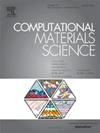Electronic structure and thermoelectric behavior of the new halide double perovskite Cs2RuGeCl6
IF 3.3
3区 材料科学
Q2 MATERIALS SCIENCE, MULTIDISCIPLINARY
引用次数: 0
Abstract
Halide perovskites are well-known for their outstanding properties. They have driven suitable advances in materials science and technology, such as tunable band gap energies, broad light absorption spectrum, long carrier diffusion lengths, and low exciton binding energies. Therefore, this study presents a novel lead-free double halide perovskite CsRuGeCl. This structure is both thermodynamically and mechanically stable, exhibiting a bulk modulus of () of 47.61 GPa, indicating a moderately incompressible structure. An indirect band gap of 2.06 eV was identified, and the band structure reveals three distinct bands near the top of the valence band. These bands serve as anti-trapping states, confining photogenerated holes and reducing the recombination rate. Additionally, the pristine CsRuGeCl also shows its potential as a thermoelectric material, achieving a figure of merit () of 0.7. The properties and characteristics of CsRuGeCl, presented here, offer a sustainable and efficient alternative to lead-based systems.

新型卤化物双钙钛矿Cs2RuGeCl6的电子结构和热电行为
卤化物钙钛矿以其优异的性能而闻名。它们推动了材料科学和技术的适当进步,例如可调谐的带隙能量、宽的光吸收光谱、长载流子扩散长度和低激子结合能。因此,本研究提出了一种新型无铅双卤化物钙钛矿Cs2RuGeCl6。该结构在热力学和力学上都是稳定的,其体积模量(K)为47.61 GPa,表明其为中等不可压缩结构。间接带隙为2.06 eV,带结构在价带顶部有3个不同的带。这些能带作为反捕获态,限制了光生空穴,降低了复合速率。此外,原始的cs2rugec16也显示出其作为热电材料的潜力,实现了0.7的性能值(ZT)。本文介绍的cs2rugec16的性质和特性为铅基系统提供了一种可持续和高效的替代方案。
本文章由计算机程序翻译,如有差异,请以英文原文为准。
求助全文
约1分钟内获得全文
求助全文
来源期刊

Computational Materials Science
工程技术-材料科学:综合
CiteScore
6.50
自引率
6.10%
发文量
665
审稿时长
26 days
期刊介绍:
The goal of Computational Materials Science is to report on results that provide new or unique insights into, or significantly expand our understanding of, the properties of materials or phenomena associated with their design, synthesis, processing, characterization, and utilization. To be relevant to the journal, the results should be applied or applicable to specific material systems that are discussed within the submission.
 求助内容:
求助内容: 应助结果提醒方式:
应助结果提醒方式:


